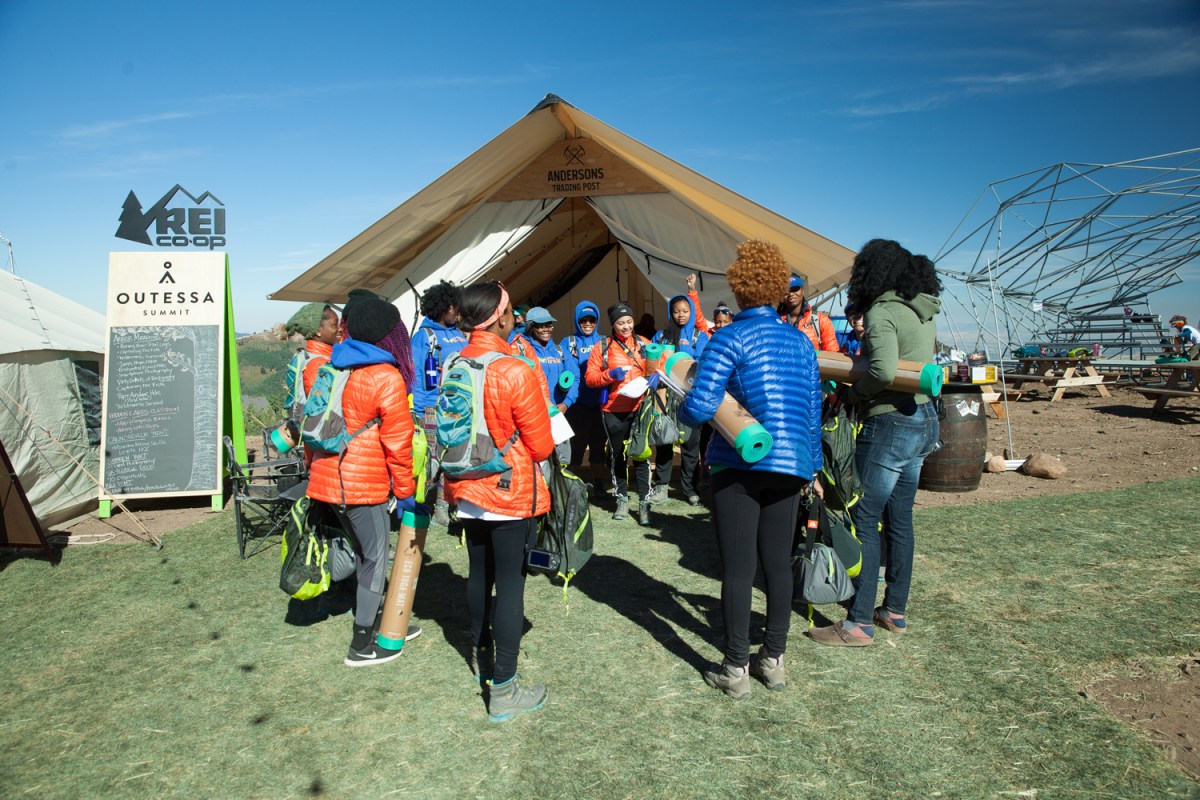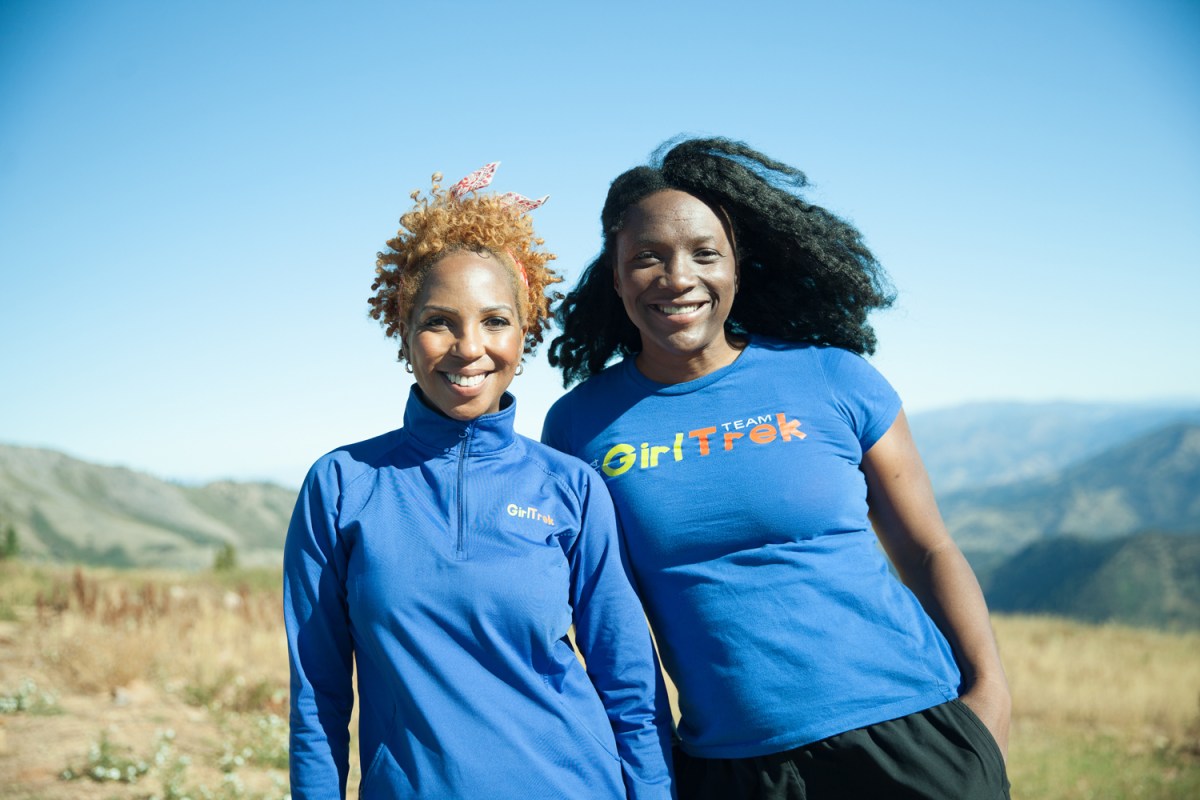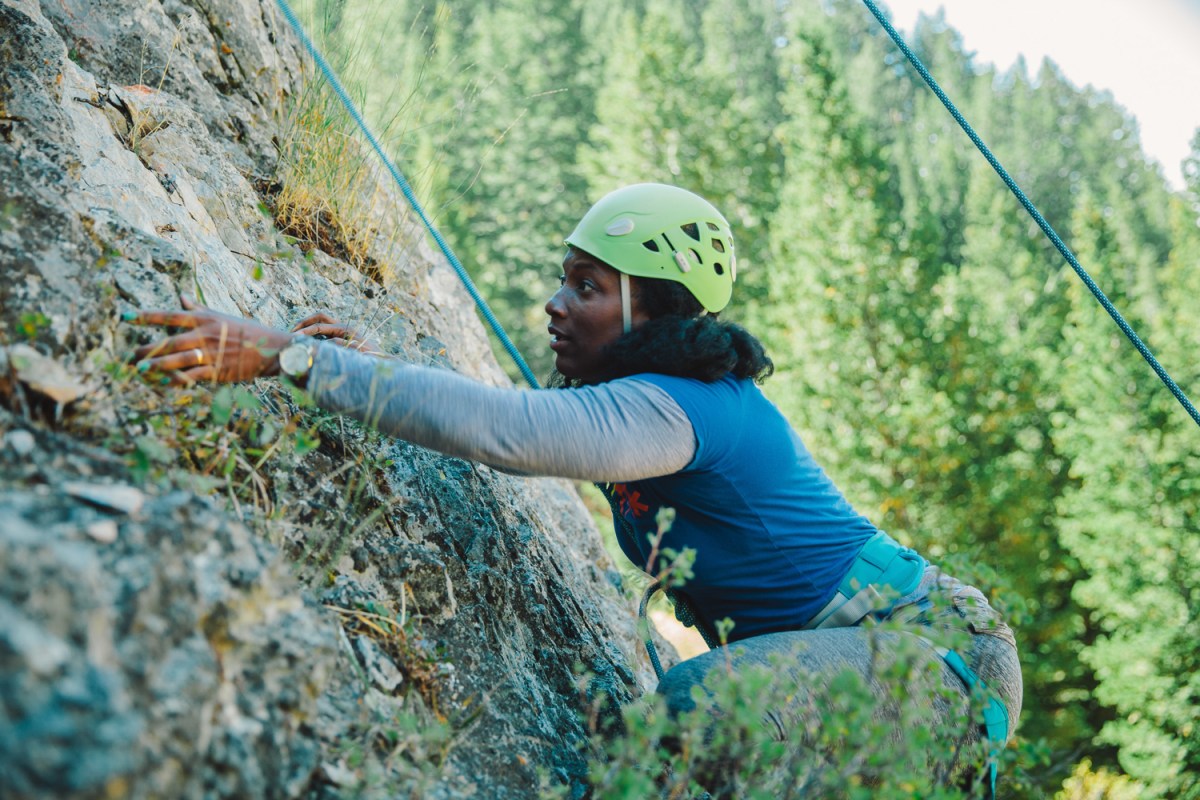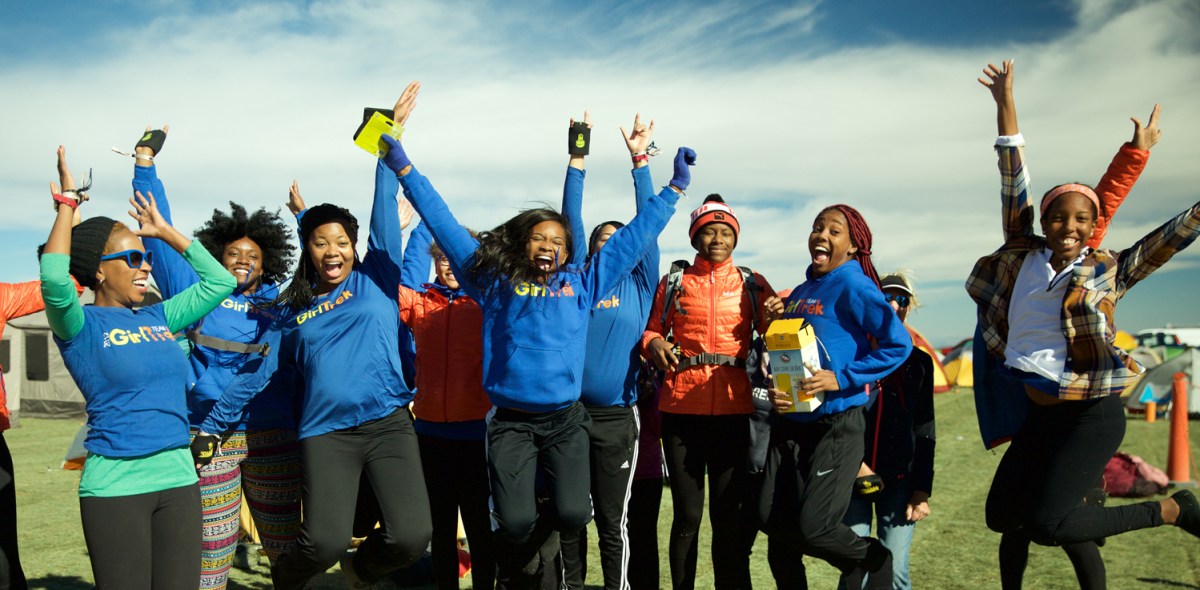Editor’s note on April 9, 2019: Our commitment to create unique experiences for women, by women is steadfast. We will not be announcing 2019 Outessa dates. We hope the expanded local and REI Adventures trips will allow us to continue to come together as women, growing and learning from each other in the outdoors for years to come. Learn more about other experiences designed for women from REI.
On a flight to Salt Lake City this September, Morgan Dixon, co-founder of GirlTrek, reflexively counted the passengers. GirlTrek is a groundbreaking nonprofit that mobilizes thousands of black women to address the health crisis in their communities, and Morgan and her co-founder Vanessa Garrison were traveling to Utah to train their first class of campus organizers, who would play a vital role in their new outreach strategy. Morgan liked to have a visual to convey the chilling statistic she carried in her mind—137 black women die of obesity-related causes every day—so she looked around and counted. “That’s like my whole plane going down,” she told me.
Morgan and I were sitting in the REI tent at the Outessa Summit, a three-day outdoor adventure, education and recreation event for women held at the Powder Mountain Resort. Perched high above Eden, Utah, at an elevation of 7,000 feet, the only indoor space was a yurt with a round, sunken sitting area and a coffee bar; the action was all outside. Tables were set up on the deck, with a panoramic view of the Wasatch Mountains and foothills covered in sage and amber grasses. Canvas tents were set up below, where women could taste probiotic teas, learn about campfire cooking, or lounge with friends. The weekend was an exercise in exposure, in both a figurative and literal sense. There was a feeling of being laid bare. Two hundred women of all skill levels could try activities they’d never done before, or push themselves further than they’d ever gone. Then there was the relentless wind and sun chapping lips and burning faces, the astonishing natural beauty, and the pure joy of being unmasked and embraced by a like-minded community. It took some acclimation.
Outessa was the brainchild of Sally Johnson, the Outdoor Programs Manager for REI. She told me she’d started with a single question: “If you’re a woman for whom the outdoors calls, where are you meeting your tribe?” It turned out that such a gathering place did not exist, so she created one. The idea was to build a bridge to cross the barriers women encounter in the outdoor space. Participants could choose their own adventure, making it as physically intense, inspirational or relaxing as they wanted. Ultimately, it would feel like being among your people.

Sitting in the big canvas tent, which smelled of nice soap and straw, and absorbing the buzz around us, Morgan and I were feeling it. As we talked, we watched a flurry of women with yoga mats and hiking packs pass by. Many of their calves were streaked in dirt, having just finished a hike or pushed through the final ascent on mountain bikes, and they had a tousled, glowing look about them.
“I really believe in the power of women,” Morgan said. “And I believe that where the mother goes, so does the household. I think that’s particularly true in African American communities—for a host of reasons that have to do with black men being the victims of lots of justice issues, leaving women to hold the weight. So it is incredibly important for black women to experience joy and health and relief and support. That’s what we’re doing.”
Confronting a Health Crisis
GirlTrek began in 2010 with a 10-week walking challenge. Morgan and Vanessa emailed 200 black women and asked them to forward the message. They received an overwhelming response from 500 walkers, and after 10 weeks, they weren’t ready to stop.
GirlTrek has since morphed into a national movement with 200,000 followers and 75,000 active walkers. They still rely on grassroots organizing and social media campaigns to spread the word, but they now have substantial foundational support and partnerships with the National Park Service and Michelle Obama’s Let’s Move campaign. Walking challenges are front and center, because, as Morgan and Vanessa often say, “walking is the single most powerful thing you can do for your physical health and mental health.” But make no mistake: GirlTrek is not a walking group. It’s activism.
“As we look at social justice issues across America, our communities are directly impacted by those histories and legacies of violence,” Morgan said. “But all of these things are really secondary to the health crisis that black women are suffering in silence.”

According to the Centers of Disease Control and Prevention, black women die at higher rates from preventable diseases like heart disease and stroke than any other group of women or men in the country. Morgan attributes that to the traumas of chronic stress, generational poverty, addiction, unemployment, failing schools and mass incarceration. The way in which people cope with trauma can sometimes make the problems worse. Comfort food, for instance, when applied like a salve.
“I think about my mom’s peach cobbler, which literally has so much sugar in it you could use it for syrup, but it’s so delicious,” Morgan said. “I think about the comfort rituals that we have in my family, like having quilts and cozying up and watching movies together, or eating soul-soothing food that makes life feel much better, or singing together. But the ones I think are toxic are overeating, using drugs and alcohol, and being in bad relationships to find love.”
The mission of GirlTrek is not to confront those vices, but to provide the first steps toward a healthier, more fulfilled life. “GirlTrek has been really successful converting people into daily walkers as a routine, as a daily meditation,” Morgan said. “It gives you one success under your belt. And from that success, you have other small victories that you start to chalk up. You walk in the morning, and you feel better, mentally. You walk a couple weeks, and you start to lose a little bit of weight. And you don’t want to go back because you have so many miles under your belt.”
The social aspect also keeps women engaged. “I know that the most powerful thing for me has been the sisterhood of women that it attracts,” Morgan says. “We attract an incredibly optimistic woman. I can’t explain why that is. I think it’s because we’re so open-sourced. There’s no heavy recruit. The only way you find out about it is from someone else’s personal testimony and then you have to take initiative to go to the website to sign up. So it’s a pretty unique culture of go-getters in our organization.”
A New Pathway for Millennials
GirlTrek’s 15 new campus organizers, recognizable in matching blue hoodies and orange down jackets, had spread out. A few were doing yoga on a platform overlooking the mountains; some were on stand up paddle boards and kayaks; others were learning about photography, wilderness survival or bike maintenance. The group had daily reflection sessions and slept in tents together, but on the whole, their purpose at Outessa was to roam free, try every new thing they could, and learn from the women around them.
Morgan told me that Outessa was more than just the background for their training; it had been the catalyst. She and Vanessa had planned to mobilize millennials on campuses long before, and had even secured funding for it, but had put the project on the backburner. As soon as they heard about Outessa, they started talking about what it would look like to bring a group of college students there. They put out a call for nominations, then interviewed finalists over video chat. About two months later, their new campus organizers were headed to Salt Lake. “It all came together in a beautiful storm,” Morgan said.

Most of the young women were already familiar with GirlTrek when they were nominated. Kelisha Stamps, a geology major from Mississippi State University, had gotten involved through her mother, who passed away a few months earlier.
“My Mom loved GirlTrek, oh my gosh,” Kelisha said. “My town is very small, and a lot of women don’t leave out of their homes, didn’t go to college, and my mom gathered them all together and they walk every single day—they don’t care what anybody say. She changed her whole life around; she was always saying everything was better.”
Because of her mother’s example, Kelisha now has a healthy way to grieve and find her strength. “I feel like now, I’m healing,” she said. “That’s the work for me with GirlTrek. I want to go back home and tell my sisters that I’m going to be there for them and help them heal.”
According to Morgan, Kelisha is one of seven girls in the group whose mothers changed their lives through GirlTrek. “Now they feel a sense of freedom,” she said. “They see a pathway for themselves. And it’s going to look way different, because they’re young and hip and spunky and they’re not going to be walking the neighborhoods with their friends. But they can be organized.”
I asked Morgan if she’d been hearing a common thread in the girls’ stories. “The most common experience is their mothers have never had leisure time to practice self care,” she said. “So they either coped in really destructive ways—bad relationships or drugs and alcohol—or swallowed it, that self-loathing and pain and sadness. They didn’t do exercise; they just never modeled it for them. So the girls are starting to fall into this trap that I know very intimately, of getting their self-worth from ambition. This year black women proportionately outpaced every other demographic, male or female, in getting advanced degrees. We’re the most educated group of Americans. We’re also the sickest.”
25,000 Healing Conversations
I found Vanessa Garrison sitting on a blanket-covered haystack in the sun, enjoying a rare moment of serenity. She had an hour before her smartphone photography hike. Vanessa often leads GirlTrek hikes to expose walking groups to some beautiful places. “One of the things we found is that once a woman starts on that path, so many things start to become unpacked,” Vanessa said. She told me about a woman on hike she’d led in Harpers Ferry, just outside of Washington, D.C. “We’d gotten to this beautiful vista, and she just starts sobbing uncontrollably. I was like, Oh my God, did she fall, what’s going on? And she said, ‘I’m 58 years old. I grew up in D.C., I had four children, and I had no idea that one hour from my house, this existed.’ And she was just in tears.”
Vanessa realized that the other volunteers whom GirlTrek trains to lead such outings had been experiencing this phenomenon of emotional meltdown. “Mental health plays such a big role in our community, and we started to realize that if we addressed that on a larger scale, a lot of the physical problems would not manifest,” Vanessa said.
That’s how the Black Girl Healing strategy was born. The goal is to reach 25,000 young women ages 18–24 within a year. The plan is to train 15 campus organizers at Outessa. Those students will go back to their communities, share their experiences, and organize a gathering of 250 young women in April. They will all be trained and certified as mental-health first-responders, after which each woman will go home and lead a thousand “Black Girl Healing conversations” with their peers.

The new organizers are excited about their role in this process. Annaya Andrews, Oschia Hodge and Claudia Brownlee, while lounging on hammocks in between classes, explained how they felt. “Oh my gosh, it’s so endless, how much we have to share,” said Annaya, who goes to McDaniel College in Maryland. “When we get back home, we definitely have a lot to offer our communities, whether it’s tangible or not.”
“It’s great being an activist for it,” said Oschia, who attends Shorter University in Georgia. “Being able to save a life, and be someone who can actually listen to them.”
The girls also felt that they had each other to lean on. “We just met each other two days ago, and when we shared our experiences from the past and the present, you would be surprised how many of us had similar stories to each other,” Annaya said. “That is what’s bringing us closer now.”
“A lot of times you feel you’re the only one who’s going through the struggles that you’re going through,” said Claudia, who goes to the University of Maryland. “And so to find someone to understand and accept what’s going on in the inside and to help you along the way, is really good. We’re trying to spread that to other girls our age, to help them figure themselves out as they’re growing and as the culture is changing.”
“I think we’ll be friends for a long time,” Oschia said.
Walking As Resistance
Vanessa grew up in Seattle’s Central District. Her family spent weekends at the mall and the race track; she had never heard of the San Juan Islands while she lived a ferry ride away, and has still not visited Mount Rainier. Now she lives in D.C., and is an avid cyclist—she’s training for a Paris-to-Barcelona trip in the spring. “When I was able to start having these experiences, I realized that it wasn’t really about the activity,” Vanessa said. “It was about opportunity. I had the opportunity and access to create whatever world I want for myself. So when I think of Outessa Summit, I think of women who are coming to realize the possibilities of their life.”
Morgan and Vanessa met in college, and they talked about the health crisis they saw unfolding around them. Those conversations were the impetus for GirlTrek. “We decided we’re not going for this takedown in our own lives,” Vanessa told me. “Let’s get out and find every crazy fun, healthy thing we can do and share it out to other people.”
That strategy remains the center of gravity at GirlTrek, and it’s working. Vanessa has seen countless transformations. “I can name at least 10 women who’ve quit their jobs,” she said. “We’re like, Is this an epidemic? Where people start with GirlTrek, and then they’re like, ‘You know what, I quit that job.’ Because they’re empowered to do so many other things.”
GirlTrek’s unique positioning is that it’s grounded in the principles and traditions of the civil rights movement. Their motto is “When women walk, things change.” Vanessa says that’s not symbolic. “It is a civil rights issue when we talk about access to health and care,” Vanessa said. “What we’re saying is, every single day that you get out walking, GirlTrek is going to knit your individual effort into this movement that’s going to change the world.”
There are some pretty tangible barriers. In cities where walkability has become a real-estate asset for those who can afford it, the first challenge is often how to walk a neighborhood beside five-lane highways, with no crosswalk or stoplights. In Jackson, Miss., Vanessa says there are 5,000 registered women walking daily in the street because they don’t have sidewalks.
“From the time I was in kindergarten, I walked to school every day, and it was my entire universe,” Vanessa said. “Along the way, my friends came out, and I waved to their families, and we stopped at the corner store, and my whole universe was my walkable neighborhood and my walkable schools.” Gentrification has been steadily changing that. Vanessa says her block used to be entirely Black families, but now hers is the last one left.
“I could point to every house and tell you the name of the family that lived there, and their history, and their connection to my family,” she said. “Those were roots that people don’t have anymore. There’s a disconnect with people moving in, in having a sort of empathy or understanding that there were families who lived in those houses. That is all connected to this conversation around physical activity and outdoors and access, and who gets to go to San Juan Island and who doesn’t. You know what I’m saying? It’s all one conversation.”
GirlTrek partners with Safe Routes to School and ChangeLab Solutions to help women address the problems in their neighborhoods. They also host advocacy training for things like writing an op-ed or conducting a walkability audit. Walking is just the first step toward change.
Random People Sit with Us
Throughout the weekend, it became apparent that the women gathered at Outessa truly did reflect the diversity inherent in a tribe of women for whom the outdoors calls. Women with different experience levels, ages, physical capabilities and cultural perspectives were striking up conversations over wine or a hike, and each had an inspiring story of personal transformation in the outdoors. Sally Johnson had seen her vision realized. “If you ask me,” she said, “I think the biggest thing you need, more than expertise, more than gear, is community.

That wasn’t lost on the millennial GirlTrekkers. I asked Taisha Gauthier, a senior at Florida International University, what her takeaway from the weekend would be. “Oh, wellness!” she said. “And now that I have this knowledge, and I’m taking the initiative in my life, it’s only right that I share that. I think that’s something that’s part of the Black identity, to constantly feel responsible for your peers. Because we need that as a community.”
Arriving as a contingent, set apart by their young ages and their matching gear, the girls might have kept to themselves, and to some extent they did—reflection sessions, shared experiences and a common goal created some serious bonding. But Annaya Andrews told me that the greater Outessa community embraced them, too. “Usually when you’re in a space like this, you expect people to talk amongst people who look like them or within their own groups and stuff,” she said. “But random people will just sit with us, like we were already friends for years. It was really nice, because I’m not used to that.”
Claudia Brownlee agreed. “Being out here in the open actually helps open me to new possibilities,” she said. “We’re all supporting each other, and it’s just wonderful.”
When I told Morgan what the girls had reported, and how it seemed to affect them, she nodded and said, “People are not quite as guarded, because they don’t have to be. That’s a kind of freedom that is a luxury sometimes, I think.”
Just the Beginning
The last night at Outessa had been a big feast, a glorious sunset, and an overwhelming feeling of celebration. The GirlTrekkers posed for photos as they roasted marshmallows by a fire pit, and they sang to Vanessa, who was celebrating her birthday on that mountaintop. It was a perfect sendoff for an exhilarating weekend. The next morning, the scene was quiet except for unzippered tents flapping in the wind, and the group of GirlTrekkers holding a meeting in the grass. Morgan and Vanessa and their millennial cohort sat in a circle to discuss next steps. They voted on who should talk to dignitaries like Michelle Obama if the need should arise (Oschia) and what their first action would be (getting their golden sneakers, a GirlTrek milepost). It was an impressive example of collaborative decision-making.

When I asked Morgan what she hoped most for the girls, she said: “That they will start to model what healthy living looks like. If that is all they do, that’s enough. But they’re such all-stars, so what they’re going to do is they’re going to model it, and they’re going to inspire the hell out of 10 of their friends, and they’re going to do some amazing stuff on their campus around health and health justice, and we’re going to support them all the way.”
From a GirlTrek lens, healthy living is a spectrum of activity, from walking challenges to marathons to wilderness trips. For those outdoor adventures, they have partnered with NOLS (National Outdoor Leadership School) to offer scholarships. This year they gave four scholarships: one for hiking the Olympic Mountains, another for kayaking in Alaska, and two for a trip to Patagonia.
“The funny thing is this: GirlTrek’s mission is to help women live their healthiest and most-fulfilled lives, right? You actually have to define that for people,” Vanessa said. “So if a woman’s never been to a place like this, then she doesn’t know what we’re even talking about. Because in this country, the dominant narrative around health is aesthetics and beauty. The dominant narrative is to exercise to be skinny, and to look pretty. For Black women who holistically reject that narrative and celebrate larger bodies, that narrative isn’t inspiring. It’s almost like an affront.”
One of her favorite hashtags is #GirlTrekGlow. “Which is, I’m sweating, I’m not perfectly posed, the light’s not perfectly on my muscle cause I maybe don’t even have any muscle,” she said, laughing. “That is what we want you to go out and do, and we use those images to inspire other women. When you’re out walking in your neighborhood in Detroit, take pictures, because we want to see women out walking in Detroit. We don’t want to see the posed photo of this Insta-model doing this thing. Because it doesn’t feel obtainable. I just think it’s a far more powerful story, across all races, for women when we see real women out there doing it.”
Real women sharing their experience and thus widening horizons is key. “Because all of a sudden, girls from Detroit and St. Louis or wherever would hear that some girl did meditation on top of a mountain in Utah, and it’s a place where she’s never been and she would want to go, and it’s not because Utah needs more Black people. Or the mountain needs more Black people. It’s because we need more people doing meditation, and paddle boarding is so fun,” Vanessa said.
It was exciting to behold the impression that Outessa had made on the young campus organizers, and to imagine the long-term effect. “More important than camping and down sleeping bags is seeing other women who are liberated,” Morgan said. “Seeing other women not wearing makeup and taking huge risks when they’re different ages, different sizes, different experience levels. I think that is an incredibly empowering instructional for girls. Exposure is everything. As soon as they got off the bus and had a 360 view of mountains—I mean, exposure is everything. It’s everything.”
Read more about GirlTrek’s commitment to a healthy lifestyle.
